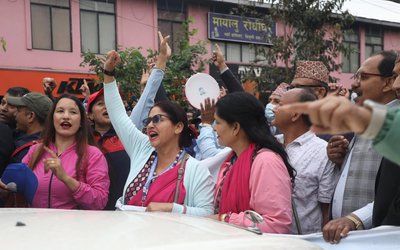
When a massive earthquake rocked Nepal on April 25, 2015, panic and chaos reigned supreme, with hundreds of people dead on that and thousands injured. Countless houses and temples were gone to the ground in no time. Even as there was a complete disorder, Nepal Army quietly mobilized its forces to reach the doors of the crumbling buildings and saved people. Despite its limited technical capabilities, Nepal Army mobilized all its units in all 14 affected districts to rescue the people trapped in the buildings.
Its helicopters hovered from one part to the other carrying the wounded people to the hospitals and providing life-saving services. Nepal Army had shown an exceptional job of handling the disaster by coordinating with other national security forces, Nepal Police and Armed Police.
Nepal Army also played a coordinative role when many countries around the world sent their military rescue missions in Kathmandu with modern equipments. With the professional skills, Nepal Army handled the situation very well.
Till months after the earthquake, Nepal Army remained the country’s major force in the rescue and rehabilitation battle. Nepal Army's rescue mission ended after clearing the debris and rehabilitating the people in temporary shelters.
This was not the first time the army had such a work. Nepal Army has always been in the forefront of natural disasters and humanitarian crises. Along with guarding the national parks and building roads in difficult terrains, Nepal Army soldiers are also providing security in many internally disturbed African nations, saving the people everywhere.
Even during recent airplane crashes and landslides in Annapurna Region, Nepal Army sent its helicopters to rescue the people, who were trapped in the mountains.
Nepal Army’s Role
Whether there is peace or disorder, Nepal Army has always been on the alert. With disasters occurring frequently in Nepal, Nepal Army is often busy in rescue and relief once the monsoon season begins.
With the sole mandate to safeguard Nepal’s sovereignty, geographical integrity and welfare of people, Nepal Army, as professional institution, has proven its capability from time to time. With the failure of all security agencies to safeguard the life and happiness of people, Nepal Army was mobilized to pressure Maoist insurgents to come to the negotiations table.
A decade after the signing of the comprehensive peace agreement, Nepal Army’s role to maintain internal peace is still there. As its credibility is so high among the local people, Nepal Army supported Nepal Armed Police and Nepal Police to bring normalcy in Dhangadhi in October and other districts of Terai.
Nepal Army in UN Mission
For the last five decades, Nepal Army has continued to serve in the UN Missions. Nepal Army’s reputation for outstanding service in UN Peace Support Operations goes back 56 years, beginning in 1958, when Nepali military observers were deployed to Lebanon. Since then, Nepal Army personnel have served in 40 UN missions, during which over 60 Nepali peacekeepers have died in the line of duty. Nepal has become the seventh largest troop-contributing nation for UN peacekeeping missions more than 100,000 to date and still counting.
There are altogether 4364 Nepalese Army officers and Personnel are deputed in different parts of the world under UN or blue helmet. These include 96 female member. The numbers go like this to show their presence everywhere: UNIFIL Lebanon 868, UNAMI Iraq 77, MONUSCO, MECH BN, ENG COY Congo 1049, UNMIL Liberia 19, MINUSTAH Haiti 3, UNMISS, SIB and FRB Southern Sudan 1583, UNAMID, F.R. Coy S.R.Coy Sudan 374, UNOCI Ivory Coast 4, UNTSO Israel 3, MINURSO Morocco 3, UNDOF Syria 157, UNISFA Sudan 4, MINUSMA Mali 150, MINUSCA , Central Africa 67, and UNSOM Somalia 1.
Currently, Nepal Army peacekeepers are serving in 13 different UN missions, in 12 countries: Sudan Somalia, South Sudan, Lebanon, Iraq, DR Congo, Liberia, Haiti, Ivory Coast, Israel, Morocco, Syria and Mali.
Nepal Army’s continuing contribution to foreign arenas of armed strife is widely recognized, admired and appreciated by the international community – something of which every citizen in Nepal can be proud.
“Nepal Army Peacekeepers have established a good reputation and recognition in upholding international peace and security. They have been performing well as Force Commanders in various peacekeeping missions,” said former chief of Nepal Army General Pyar Jung Thapa in his interview.
Protection of National Park and wildlife Reserve
Nepal Army is now providing security to nine National Parks and 3 Wildlife Reserves deploying 7627 military officers and personnel. Since April 2015, Nepal Army has also deployed its 849 personnel in Dhorpatan wildlife reserve and Makalu Barun National Park. Nepal Army has established Nature Protection Institute to further strengthen nature conservation work. Due to its vigilance, Nepal has been able to mark Zero Poaching Years in 2011, 1013 and 2015. Nepal Army has been playing a key role in protection of wildlife and natural heritage. Out of 20 protected areas, Nepal Army has been protecting 12 areas and it will add another two in the near future.
Road Construction
Since the first modern road construction, of Kanti-Rajpath linking Kathmandu valley with the rest of Nepal, Nepal Army has been supporting the construction of new roads strengthening national unity linking the remote parts of Nepal with the rest of the country. It was Nepal Army that opened the Kathmandu-Nijgadh fast track.
“Nepal Army has already constructed 28 roads with 1178.56 kilometers in length. Nepal Army is now constructing four roads, Jajarkot-Dunai, 117.77 km, Kaligandaki Corridor (Gulmi-Baglung 75.5 km, Karnali Corridor (Khulalu, Laiku, Simikot 196.347 km), Betrabati-Mailung-Syaphrubeshi (29 km). Nepal Army has been supporting the government carry out the road projects in remote parts of Nepal,” said spokesperson of Nepal army Brig Gen Tara Bahadur Karki.
COAS Command Guidance
Soon after taking command of Nepal Army, COAS General Rajendra Chhetri issued the Command Guidance – 2015. The guidance highlights the role played by Nepal Army in safeguarding Nepal’s sovereignty, geographical integrity and National Unity. The Command Guidance hails the role played by Nepal Army serving the interest of Nepalese people, living with them at the time of pain and happiness and peace and disturbance.
Reminding the key role played by Nepal Army during the great earthquake of April 25 in search and rescue and international recognition, COAS General Chhetri recounted the recognition given by international community.
Similarly, COAS Command Guidance also talked about the important contributions made by Nepal Army in UN Peacekeeping Operations around the world in the last 50 years.
As the world order is changing and technology is changing, Nepal Army also needs to modernize itself as per the new world order to safeguard national unity. The Command Guidance also highlighted Change Management, Human and Material Resources Management and Knowledge and Technology Management.
The guidelines stress the need to change the mindset and work with loyalty and dignity and pride of Nepal Army as Brave Gorkha. The Command Guidance spells out the importance of Nepal Army in the national security and it directs army personnel to be proud of their institution and its role in defending the nation.
Friends in Need
Despite the fact that no authority or leader advocates Nepal Army's causes and, at the bureaucratic level, no institution exists to take care of its bare necessities, the way Nepal Army has been managing to function well is amazing. How much is the budget provided to the army, the first institution to be called for duty at difficult times?
During the time of monarchy, the monarchs were sensitive about the contributions of the army whose personnel would be rewarded for their sacrifice. In the present times, politicians are declaring any Tom, Dick and Harry as a martyr. However, the government has not given anything to personnel, such as when they died at helicopter crashes in the last earthquake.
People have the right to know whether the governments, past or present, have given a thought to rewarding the families of soldiers who lost their lives during the course of earthquake relief work and those who successfully handled rescue operations risking their lives.
Where others have failed, the army has been the one to come for rescue -- whether it is a case of fire, disaster, conflict or accident. Army personnel are the first to reach to emergency sites, be it at road, national park or elsewhere. No authority, not even the parliamentarians, have genuinely appreciated the army personnel for the risk they take for the nation and people, and, for their unparalleled contribution.
Politicians are more concerned about how to control the army rather than appreciating the army’s contributions. Nepal Army personnel extended their full support to make the constituent assembly elections free, but there were political leaders who cried foul for no reason. Instead, these same parliamentarians passed the bill to control the Army’s role.
In all democratic countries including United State States and India, politicians defend the national army for its contribution. It is time Nepali people and authorities realized their national army as friends in need.
Rather than criticizing the army, political leaders will do well to raise the issue of how Nepal Army personnel are living and working, their conditions, the weapons they need and the budget the government provides them.
Nepal Army History
As Winston Churchill says every nation or group of nations has its own tale to tell. Knowledge of the trials and struggles is necessary to all who would comprehend the problems, perils, challenges and opportunities which confront us today. It is not intended to stir a new spirit of mastery or create a mood in the study of history which would favor national ambition at the expense of world peace.
Historian John Whelpton and historian father Stiller regard Nepal Army as a force which came along with the institution of monarchy. Nepal Army continues to march with Prithvi Narayan Shah’s quest of building a Hindu nation from 1743 till 1816 when Nepal signed Sugauli Treaty British India. As Nepal turned from a monarchy to a republic and from a unitary to federal setup, Nepal Army has remained to be the sole institution now to defend the national unity and integrity. With the promulgation of new constitution in September 2015, Nepal Army continues to discharge its duty in the fragile situation.
Although Nepal Army was an institution started and implemented the mission of unification under the Badamaharaj Prthvi Narayan Shah,Nepal army institutionalized under a barrack system in 1819 B.S, (1862 AD). During the period of 1744-1862, there were no barrack system and other political institution to back Army. According to Stiller, the story of Nepal’s growth as a nation spans the year from 1744 to 1951. Historian Whelpton writes in his book Kings, Soldiers and Priests that Prithvi Narayan Shan conquered Kathmandu with support of Nepal Army in 1769
As Nepal Army is celebrating the Nepal Army Day, the security agency's challenge is to continue to defend national unity and integrity as the small princely states had been integrated since 1743 by Prtithvi Narayan Shah.

Keshab Poudel
Poudel is the editor of New Spotlight Magazine.
- KUL MAN GHISING: Bowing Down To The People
- Apr 13, 2025
- POLITICAL VIOLENCE: Culture of Impunity
- Apr 11, 2025
- PM OLI MEETS PM MODI: No Progress
- Apr 09, 2025
- PM OLI’S THAILAND VISIT: Flip Flop
- Apr 08, 2025
- FM Dr. Deuba’s India Visit: Mission Aborted
- Mar 26, 2025















